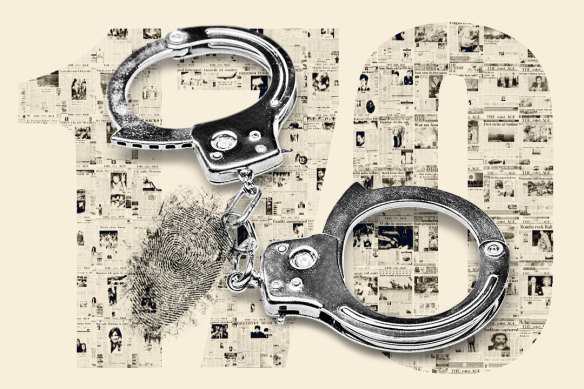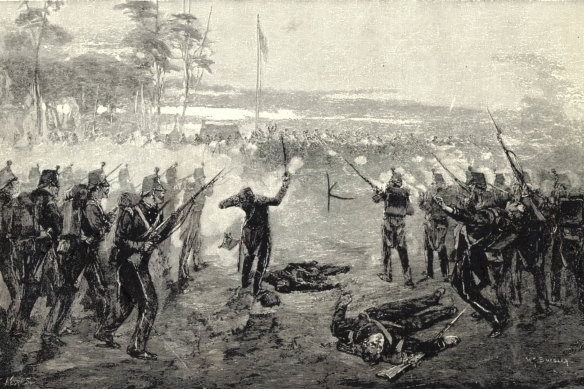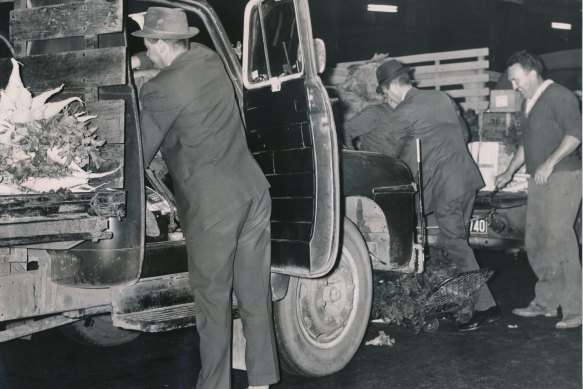This was published 9 months ago
Celebrity crooks existed long before Carl Williams. The method’s different, but the aim is the same
Gangsters, massive protests, drug busts and police corruption have been around as long as The Age. Here’s a look back at Melbourne’s underbelly decades before the Underbelly war.

Crooks, cops and crooked cops have featured in Age reporting over 170 years.Credit: Marija Ercegovac
One year before The Age’s first edition hit the dusty, unmade Melbourne roads, Victoria Police was formed. The relationship between the two institutions has varied from combative to co-operative.
The Victoria Police Force was established in 1853 with an initial strength of 900, including 26 “gentleman” officers who continued to operate private businesses to supplement their income.
We tend to think of modern policing as a dangerous business, but then it was more dangerous. Even with a small workforce, 24 police were killed on duty in the first 10 years.
Police were shot, fell off horses, hit by trains, drowned, and one was killed by a prisoner using a hammer as the murder weapon. A constable, sacked for drunkenness, shot his sergeant dead.

The attack on the Eureka Stockade.
In recent times, there has been controversy over police clashing with demonstrators, but that pales into insignificance compared to December 3, 1854, when The Age was just six weeks old.
When miners gathered at the Eureka Stockade to protest against the crippling gold tax, about 300 soldiers and police attacked, leaving 22 miners and five soldiers dead.
While present-day Chief Commissioner Shane Patton says Melbourne is the protest capital of the world, one of his predecessors was less tolerant.
In 1928, when dockworkers massed at Princes Pier to protestagainst the use of scab labour, then-chief commissioner Tom Blamey said marchers should be “hit over the head” while mounted police armed themselves with pick handles.
Dockworker and Gallipoli survivor Allan Whittaker was shot dead by police. Despite evidence Whittaker was shot in the neck while turning away, Blamey declared: “I have no hesitation in saying that the action of the officer in charge was fully justified.”
Blamey hated nosey elements of the press such as The Age, and had surveillance police (including Jim Cairns, later deputy prime minister) follow journalists.
Blamey was forced to quit in July 1936 after telling lies to the media about how one of his senior officers was shot. As usual, it wasn’t the incident, but the cover-up, that cost him his job.
In May 1936, police had initially released a statement saying Detective Superintendent John Brophy “had been shot in the right arm accidentally while handling a pistol”.
The Age reported the detective had four bullet wounds, including in the neck, and when a reporter visited him in hospital to ask about his injuries, the wounded policeman referred them to police headquarters.

Detective John Brophy (right) with colleague Fred Piggott in 1950.
The truth then emerged. Police issued a statement saying that in fact, Brophy had been shot four times by car bandits he was chasing in Royal Park a couple of days before, and his pistol jammed when he tried to return fire, The Age reported on May 25, 1936.
“Owing to the drag net which was being placed around the bandits, who had been operating there for some time, it was considered advisable not to release the true facts at the time … Owing to the false rumours which got about and were published, it is now considered advisable to release the true facts,” the police statement said.
The massive illicit drug market and the police methods to catch the supplier have always been front-page news.
Police understandably knew they had to act when they received disturbing reports the use of cocaine was rising. They used the cutting undercover technique known as “buy-bust” to infiltrate the dealers.
Two constables, wearing borrowed army uniforms, walked into chemists in Smith Street, Collingwood, and Russell Street, Melbourne, and asked to buy “snow”. They were given 4.5 grams and 3.5 grams of cocaine respectively.
It was January 30, 1919.
The debate on crime and punishment has always been examined by The Age. Today, it is issues such as bail, youth crime and the perception (most often wrong) that courts hand out soft sentences.
In Victoria, 186 people have been executed. The most famous cases include bushranger Ned Kelly (November 1880); the Brownout Strangler, US serviceman Eddie Leonski (November 1942) who killed three women; Jean Lee (February 1951), the last woman hanged; and the last person hanged, Ronald Ryan (February 1967).
The Age and other newspapers campaigned against capital punishment before Ryan’s execution, but then-premier Sir Henry Bolte was determined to see him hanged. So concerned was Bolte, he tried to persuade The Age board to tone down its editorials. While the build-up was headline news, Melbourne newspapers chose to report the actual hanging in a few paragraphs.
According to a brief report on The Age’s front page of February 4, 1967, headlined “Ronald Ryan hanged”, he “made no statement on the gallows”. “The Age was represented at the execution, but will not publish an account,” the report said.
A larger front-page news story, “Hanging policy staying, says premier”, reported that Bolte “had rejected any possibility of an early change of government policy on capital punishment”.
Colin Campbell Ross was hanged in 1922 after he was convicted of killing Alma Tirtschke, 12, in the case known as the Gun Alley murder. Ross went to the gallows maintaining his innocence. In 2008, he was pardoned when fresh DNA evidence showed he was not the killer.
In March 2000, The Sunday Age revealed that new forensic tests conducted on hair samples researcher Kevin Morgan had found in closed court files proved Ross was innocent and “demolished the only substantial evidence in the weak case” against him. The Crown had relied on human hairs found on two blankets taken from Ross’ home. “New forensic tests, carried out by an Australian Federal Police expert, Dr James Robertson, show the hair on the blankets was not Alma Tirtschke’s,” The Age reported on the front page. Then-attorney-general Rob Hulls said: “Justice should be done no matter how old the case.”
Three major police controversies were the police strike of 1928 (which led to riots, looting and more than 600 members being sacked); a 1970 judicial inquiry that found senior members of the homicide squad had been taking bribes from illegal abortionists; and the 1975 inquiry led by Barry Beach, QC, into police fabricating evidence – including confessions – to gain convictions.
The police rebelled and started a work-to-rule campaign, demanding all those charged were granted committal hearings. The government agreed. Of the 55 police named by Beach, 33 were charged and none were committed for trial. It was the start of a journey that would lead the Police Association to become one of the most powerful unions in the state. Beach was elevated to the Supreme Court and was respected by police as a hard and fair judge.
With the controversy came compassion. There was public grief over the 1988 ambush murders of Steven Tynan and Damian Eyre in Walsh Street, South Yarra, and the 1998 murders of Rod Miller and Gary Silk in Cochranes Road, Moorabbin.
The Age’s decision to run a front-page aerial picture of Silk’s body outraged many cops. The Australian Press Council investigated, but dismissed a complaint by then-chief commissioner Neil Comrie that the publication had invaded the policeman’s privacy and offended the sensitivities of those close to him.
Then-Age editor Michael Gawenda told The Australian: “It was a confronting and shocking picture. But I wouldn’t call it particularly graphic. What happened [to Silk and Miller] was confronting and shocking. I think this reinforced in people’s minds the horror of what happened. If I had the choice again, I’d publish that photograph.”
In 1986, a gang of armed robbers with a pathological hatred of police planted a car bomb outside the Russell Street police building, killing Constable Angela Taylor. Dux of her class at the Police Academy, she had lost the toss on who would get lunch for the staff at the city watch-house over the road. She was walking to the canteen when the bomb detonated.
Decades earlier on July 13, 1936, someone threw a bomb into the Geelong home of Senior Detective Fred Milne. His wife, Aimee, woke and grabbed the bomb to throw it out of the house when a second rolled in. She was killed in the blast and 83 years later awarded the Victoria Police Star.
Long before the Underbelly TV show, Melbourne gangsters tended to become celebrity crooks, although they rarely made it to old age. Squizzy Taylor was shot dead by Snowy Cutmore in a shootout in 1927, Freddie “The Frog” Harrison was gunned down at the docks in 1958, and Alphonse “The Black Prince of Lygon Street” Gangitano was killed in his home in 1998.
Crime in Melbourne could be violent but tended to be local, almost broken into suburbs.
The first sniff of organised crime was the illegal gambling industry, which was massive in its day.
Every police station was being paid off; every one of Victoria’s 1600 pubs and most laneways had an SP bookmaker. By the 1950s, it was part of a $500 million industry that had corrupted 60 per cent of street police and employed 100,000 people, including newspaper racing reporters who could update the syndicate from the track.
A small police taskforce, the special duties gaming branch, led by Senior Constable Mick Miller, who would become chief commissioner, embarked on a series of headline-grabbing raids that led to the 1958 royal commission and the establishment of the TAB three years later. It was the beginning of the billion-dollar (legal) gambling industry in Australia.

Police search for weapons during a dawn raid in 1964 on Victoria Market as part of an investigations into mafia-style shootings.Credit: Ken Wheeler
The first public acknowledgment of international organised crime was the 1963-64 Melbourne Market murders – a power struggle for the control of the Calabrian Honoured Society.
It began a 20-year cycle where gangsters would go to war, sparking public executions and a huge police response, which was bad for business.
When we had a cash economy, there were armed robberies every day, many carried out by gangs that planned with ruthless efficiency. In 1976, the Bookie Robbery team hit the Victoria Club. Six bandits, armed with submachine guns, grabbed 118 calico bags filled with cash on bookie settlement day. The haul was listed as $1.4 million, but no one knows the real figure.
The team’s boss was Ray Chuck, and a standover gang wanted a slice. This led to the murder of Les Kane in his Wantirna home, the payback murder of Chuck inside the Melbourne Magistrates’ Court, and the murder of Kane’s brother, Brian, inside the Quarry Hotel.
In 1999, drug manufacturer Carl Williams was shot in the belly in Gladstone Park by Jason Moran, who was with his brother, Mark. This led to the Underbelly war, the Purana taskforce, barrister Nicola Gobbo becoming a secret police informer, and a $200 million royal commission.
The iconic image captured by The Age’s photographer, Angela Wylie, of Carl Williams’ arrest was the moment the momentum finally shifted. At one time, the crime team was granted access to a corporate box at Marvel Stadium. One of the guests was Nicola Gobbo, who arrived after a lengthy lunch. She was loud, inappropriate and highly amusing. It was only at the later royal commission we learnt she had reported back to her informer handlers on what had happened in the box. She also documented that drug dealer Tony Mokbel had referred to this reporter as the bald-headed alien.
When Williams pleaded guilty to three underworld murders (he was already convicted of one), The Age was finally legally free to tell the story in a multi-thousand-word piece published on deadline.
While the method of delivery changes, the aim is the same. Once crooks met in pubs to plot a crime, then it was secret calls from public phone boxes, then it evolved to encrypted messages from gang bosses living in the Middle East.
Now we have Melbourne’s illegal tobacco wars, resulting in at least 100 arson attacks. The cycle continues.
John Silvester lifts the lid on Australia’s criminal underworld. Subscribers can sign up to receive his Naked City newsletter every Thursday.